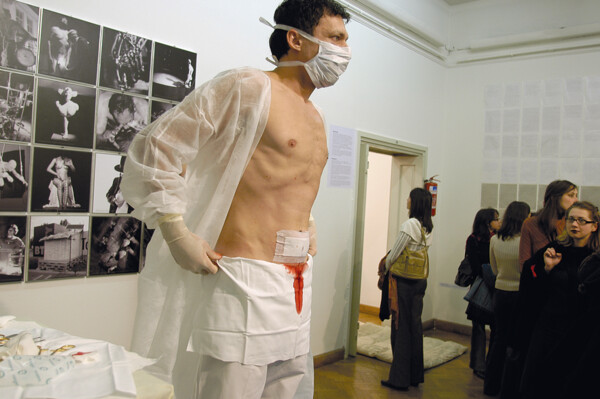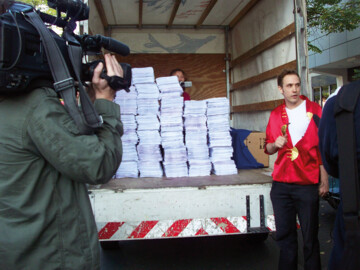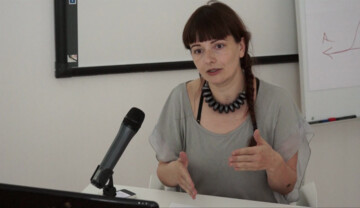The phenomenon of artists fighting for the right to share, distribute and experience cultural contents outside the boundaries of local economies, politics, or laws is not limited to the present time. The arguments, which condemn the existing copyright laws as opposing the idea of the commons are as old as Marx’s argument on the Theft of Wood, and Working-Class Composition. The argument states that in the case of claiming ownership over fallen trees the law is nullified, when applied to the exclusive advantage of the particular → interests of an isolated group. This means that the interest of the public is transformed into private compensation. By applying the category of theft where it ought not to be applied one exonerates it. The call of various initiatives in the copy-left movement with hacktivists and artists alike follows this argument. The act of piracy and theft is not an act of violence but rather one of kindness, it is aimed at promoting the allowance of cultural ambivalences, and it delineates from antagonisms when sharing immaterial cultural property. In these movements initiated by activists and artists alike, the right to share and wilfully renounce the market value of a cultural product is to allow for → collaborative, i.e. collective, modes of creating. The creators of open codes do not disown their work, but only allow it to change, grow, enhance and in their way create a new gift-economy. It must be noted that geek communities as groups share a moral order of openness and freedom, which sometimes may be quite naive. I once believed that the almost invisible DIY technological revolution, which took and is still taking place in art studios, media labs and fab labs, may shift closed-source systems. I no longer entirely believe in this potential, although this does not mean that the impotence of this endeavour is any less valuable, since it produces deeper cultural meanings that go beyond the prevention of purchasing the latest consumer gadget.
Copyright claims to protect the rights of the creators. What it does is protect the property of the rich and successful. To prove a point, in the dispute of the so-called collective agreement of GEMA (Gesellschaft für musikalische Aufführungs [Society for Musical Performance in Germany]), the artist Johannes Kreidler subverted the autocratic system of copyright laws in his multimedia theatre piece Product Placements from 2008. If one wants to register a song at GEMA, one has to fill out a form for each sample one uses, even the tiniest bit. At the time when the work by Kreidler was made (2008) GEMA stated that: “The widely believed notion that 8 or 4 bars may be used without permission is incorrect”. Thus, every copied bar should be reported and accounted for. With this instruction the bureaucratic machine of GEMA denied the right of remixing digital artworks and denied the right of the musicians to promote the idea of sharing. In Product Placements Johannes Kreidler pushed the concept of the culture of non-sharing to the extreme by creating a 33-second-long computer-generated noise composition using 70,200 musical quotations, i.e. samples. In some way, he created the most illegal sound art piece in history. To officially register his new composition, he prepared the required 70,200 forms and announced he would deliver them to GEMA on 12 September 2008 to demonstrate the need for reforming the copyright collecting agency. (Figure 1) He demonstrated a completely absurd amount of administrative work in an effort to comply with the outdated registration requirements in a time of digital reproduction. He proclaimed that music does not exist on its own. It is connected with the politics of technology, consumption behaviours, market fluctuations, and the economic value of art. One of his statements was that the aesthetic question can never be identical to a legislative question, seeking → autonomy of his work.[1] The action met with international acclaim and forced GEMA to officially state that not every bit of music must be registered with a form. This only proved that GEMA interprets the copyright law and the idea of intellectual property theft differently however it may suit it, while the artists must abide by its laws. GEMA treated intellectual property in the same way as material property, being completely oblivious to the new cultural context of digitally produced artworks. The most urgent question that also concerns SAZAS (a similar organisation in Slovenia) is the idea of quantitative value measures of artworks. A member of GEMA earns as much money as there are users, as in the number of views on YouTube, but makes no effort to recognise the cultural value of less popular, experimental artworks. The answer is obvious, the majority is stealing the right of artistic minorities to exist, share, and enjoy the fruits of the social surplus.

Figure 1: Johannes Kreidler, Product Placement, action, 2008. Photo: Julia Seeliger (Flickr, CC BY 2.0)
The question of the ownership of digitally-produced artworks was also provoked by the Ljubljana-based radio-art collective radioCona (Brane Zorman and Irena Pivka) 88.8MHz in their 2008 Temporary Project Radio for Contemporary Arts broadcasts. RadioCona explicitly stated that it supports regulated copyright, though it does not support the obstruction of creativity that takes place through the implementation of the copyright laws in force at present. In practice, this happens rather often; for example, one cannot perform one’s own artistic work in a public space without having to pay a reimbursement to the collective organisation SAZAS, from which an experimental sound-art platform can never benefit because it simply never reaches a large audience compared to pop culture works. The experiment by radioCona was rather simple and humorous. They made a field recording of singing birds, then played it on radioCona. Before each broadcast they posed a question: “Who is the creator of this recording, and thus the property owner of the piece: the birds, the one who recorded the sound, the one who played it on the radio, or the one who was listening?”[2]
Such aspects of theft and stealing are gestures and expressions of the power struggles and key tactics for actively creating an opposition to the dominant and normative relations. The art of stealing is by no means an invention of the digital realm. However, the conditions of digital production pose particular questions that are not known to the “common thieves of art”.
One of the artistic example of stealing things is by artist Ivan Moudov, whose work is also a part of Moderna galerija collection. He was stealing small fragments of artworks by other artists exhibited in the museums of the West with his collaborator Alberta Pane. He then neatly placed them in Fluxus-like suitcases as trophies for a new Bulgarian national collection. Ivan Moudov is in this respect a thief – however negative this attribute may be – it is not his moral obligation, but rather an artistic strategy by which he acts as an → intervenor, placing both his art, and the art of Bulgarian artists, into the contemporary, international and global art context. Moudov’s work has a particular significance, as it enabled him to “participate in colonial art history” by looting the treasures of one nation to add to his own national collection. Recognising the colonial relations between the East and the West Art Hemispheres, Moderna galerija invented a series of entirely legal yet still cunning tactics to create an international collection in order to form a dialogue, and present important artists from Eastern Europe who had been unknown or overlooked (such as Moudov). With regard to theft, Moderna galerija also initiated some exhibitions which were dealing with a positive evaluation of non-normative behaviour, which might be considered as illegal, criminal, or just morally unacceptable. One such exhibition was Seven Sins: Ljubljana – Moscow (2004–2005), which dealt with Eastern European identity through seven typical characteristics: Collectivism, Utopianism, Masochism, Cynicism, Laziness, Non-professionalism, and Love for the West. All these can be understood as deficiencies or weaknesses, but also as virtues. (Figure 2)

Figure 2: Ive Tabar, "Acceptio", performance, 20 December 2004, a part of 7 SINS: Ljubljana – Moscow, chapter "Masochism", Kapelica Gallery and Moderna galerija co-production. Courtesy of Moderna galerija, Ljubljana.
This means that criminal behaviour is not an objective thing. Theft in the digital realm may also be viewed as a form of virtuous behaviour. Theft often have a disruptive rather than a destructive power, it is a manifestation of ambiguities and contradictions rather than a result of direct confrontation and spurring antagonisms. Like Moudov, digital artists focus on illegal art tactics. Instead of a suitcase, their trophies are infringement letters. Performance artists promote controversial forms of art, using guerrilla tactics to protest against the fairness of intellectual property laws or privacy policies online. An Italian curator Simona Lodi humorously said that any artist interested in taking part in the movement chooses a good lawyer rather than a good gallery owner, since their art interventions investigate the boundaries between art and freedom, the end of techno-utopias, and the way business has co-opted hacker values, open source initiatives, and web freedom.[3] This means they are stealing digital data when the → interest of the commons was transformed into private compensation. It also means that, from the perspective of a hacker, the private owners have stolen the right to freely distribute cultural goods or own their own identity. One such case would be the stealing of identities by Italian media artists Alessandro Ludovico and Paolo Cirio. They managed to expose the strict policy of data control perpetuated by the social networking corporation, and the implications of this for privacy and users’ rights. Their hacker project Face to Facebook functioned by “Stealing one million Facebook profiles, filtering them with face-recognition software, and then, posting them on a custom-made dating website, sorted by their facial expressions and characteristics”.[4] Of course, it was also an ironic attempt to disrupt Facebook’s policy, but at the same time a way to expose the vulnerability of personal data on a social networking platform.
The values which hackers and artists assign to a particular stream of data may vary in form. Usually it has to do with producing pranks, confusion, memes or just stealing time. They protest by completely disregarding the stakes which are estimated the highest by the info-capitalism, that is monetary value. The closest they come to monetary value in recent years is when trying to hide their traces through proxy servers when purchasing illegal goods by shopping with bitcoins on the dark-web. The significance of time in relation to capitalist production is evident in the attempts to steal time by artistic misfits who try to express civil disobedience. One such protocol is the so-called DDoS – Distributed Denial of Service attack – oriented at saturating the server of the target with massive external communications requests, usually making the computers effectively useless.
Such acts must stay in the realm of disobedience, because the normalisation of sharing and stealing by hackers and activists has been to some extent capitalised and assimilated to the mainstream culture in the form of entrepreneurship and participation of hackers as well-behaved citizens of info-capitalism. The rule is: when capital is threatened, it co-opts its opposition. This process of fake inclusion may also be observed in the promotion of female computer programmers, which has been in fashion in the last five years. The idea of female programmers only became acceptable when there was a demand for more women in the workforce by the market. By some estimates, by the year 2020 there will be a deficit of 80,000 computer science professionals in Europe alone, and that is why the female workforce must be exploited. The acceptance of women in technological professions is therefore not just the benevolent result of persistent → emancipation. The question is still who is stealing what from whom.
The commons, especially in the so-called brand of Creative Commons, is not an independent realm. It is a dynamic object that falls into a field of forces defined by the laws of value and production. The network economy and monopolies of communication can now easily exploit, for instance, the generously provided Free Culture without imposing any form of traumatic enclosure or strict regime of intellectual property. The digital commons are not autonomous, they are infested by corporations and processes of gentrification of creativity. The idea of creativity has been one of the mind tricks used for voluntary exploitation of the new workforce. One such latest fad –crowdsourcing – which still bears the illusion of potentiality, feeds the competitive nature of → labour in the cultural industries. The artistic mode of production in crowdsourcing exists for the sake of creating good values of citizenship, public good, and accessibility, which are in themselves modes of gentrification not modes of cultural production. In this sense cultural production is a zombie, and the only way to make culture alive is in reversing the chain of value generation. In this way tactics of stealing or sabotage can equally be seen as creative and productive. When the cultural production is aimed at non-normative behaviour it is dynamic, and when it is aimed at “creative destruction” it must likewise be understood as belonging to the contemporary multitudes and the commons.
The idealised vision of the commons as a product of networking culture bears another trap which is often neglected, yet it provides the basic energy flow into the networked organism. All immaterial commons have a material basis. The political terrain for media theory is not only in the digital production of knowledge but in the material reality of the so-called “energetic unconscious” which is manifested in the energy crisis. The production of electricity and energy is at the heart of the mediascape. This is the very real impact of the digital life which appears so purely immaterial and sanitised. It is one of the production forces that are behind the anthropocene, causing earthquakes, droughts and other natural disasters affected by and affecting humans. It is of course not the only driving force behind conflicts, but it is one of the often-overlooked contributing factors. To illustrate this, I would like to use an example of an art piece by Michael Saup. He created a simple algorithmic piece calculating the energy consumption of one pirate server, providing P2P downloading of digital content. The use of the energy in the span of one month was a pile of black coal the size and volume of the Great Pyramid. Any digital action has therefore a direct energetic impact. (Figure 3)
Figure 3: Michael Saup, Pyramis Niger – the avatar of the Internet, 2009. Courtesy of the artist. Photo: Ricardo Liberato. In the background: "A lignite coal pyramid with a base side of 1,422 meters and a height of 905 meters created by the electrical power consumption of the Internet in 2009, totaling 1,000,000,000,000 kWh’s. The lignite briquettes would create a line 1.5 times as big as the distance between Earth and Sun." (1001suns.com, CC by-nc-sa 2011–2012)
This energetic interpretation of technology directly contests the dominant paradigm of Media Studies, that reduces and neutralises the network to a dialectics of two internal coordinates: digital code and the flow of information. In contrast, any system should be defined by the external excess of energy that operates it. The call to consume less will continue to remain ineffective until the capitalist core of production is questioned.
In conclusion, I would like to contest the notion that networking is somehow producing the commons, implied by the idealised version of the Free Culture and Creative Commons. Being an active member of the free culture, open source software and free hardware movement, I have serious doubts about the:
1. impact that it makes in the face of the global market;
2. the self-righteousness of the movement trapped in its own morals or geek ethics;
3. the swift appropriation of any genuine change in the movement by the forces of info-capitalism.
Who is stealing what from whom, and who is to decide on the verdict of criminality?






